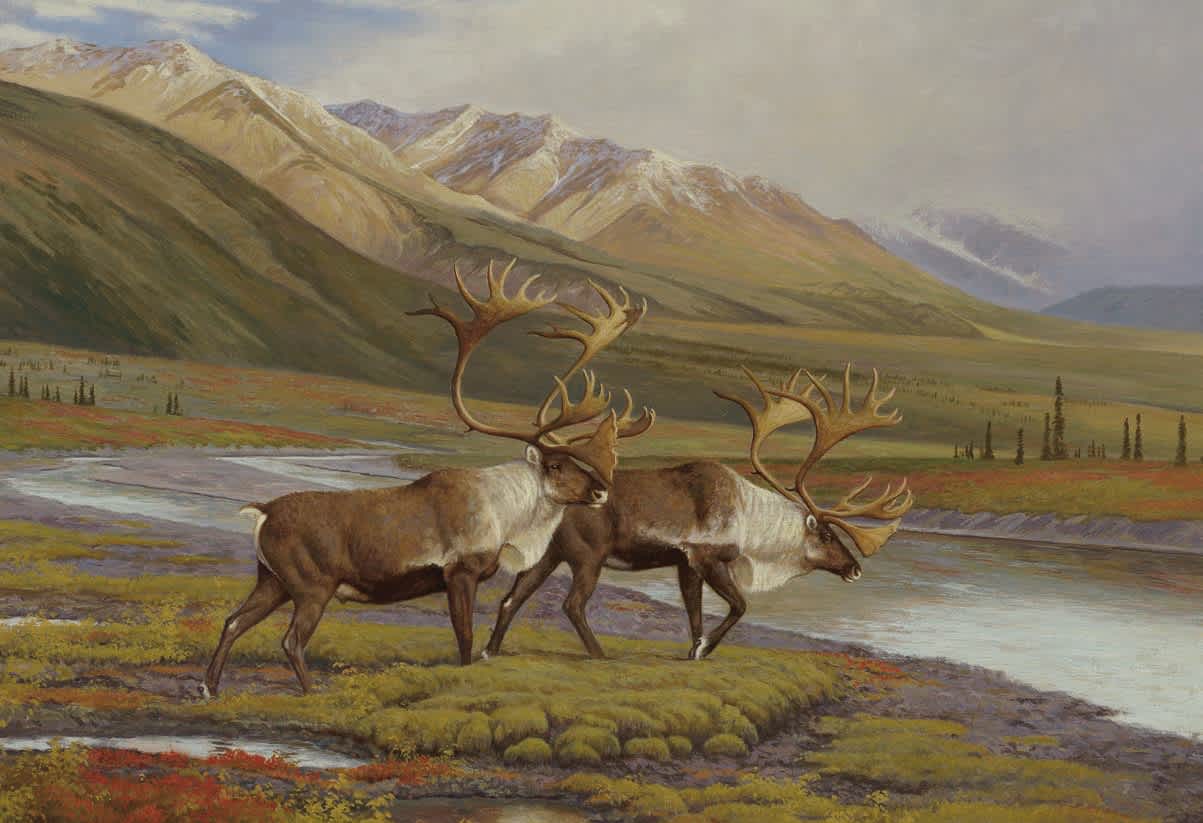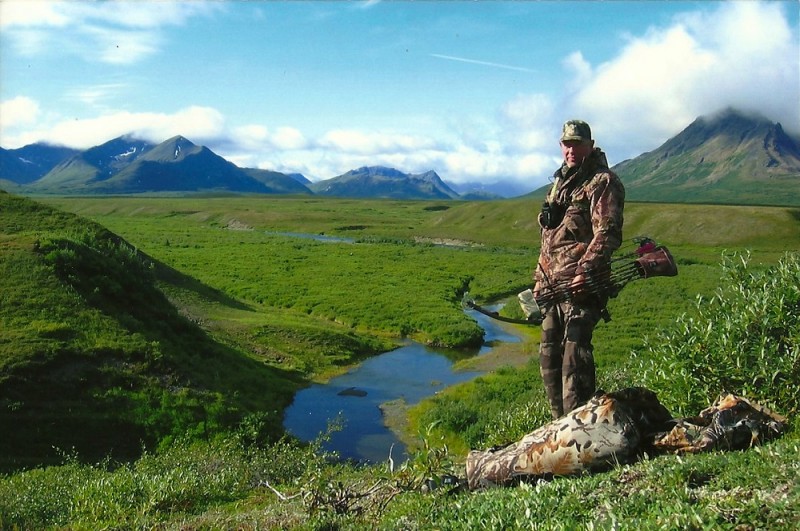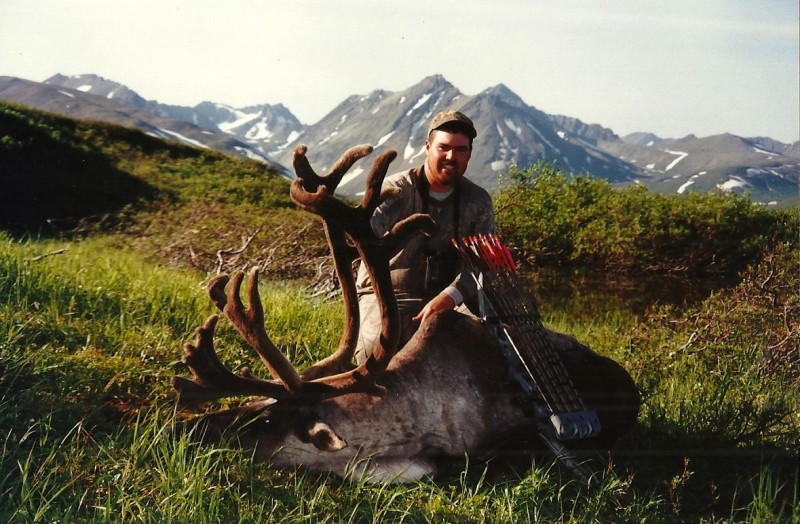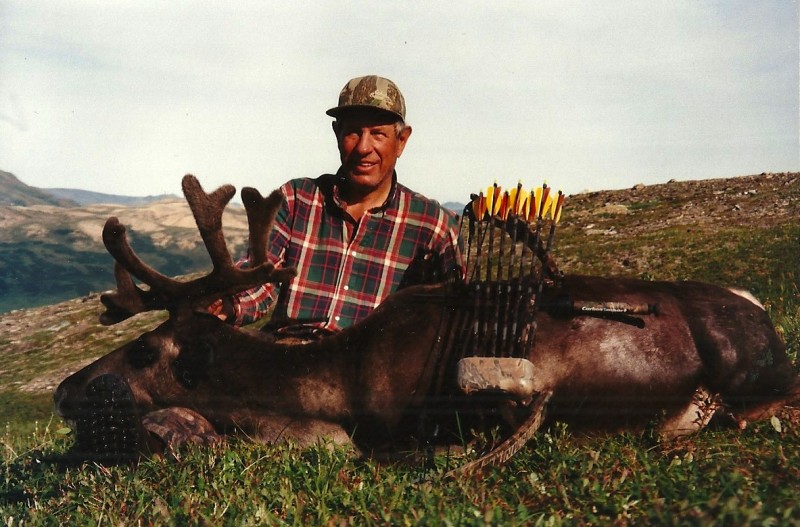The BAREBOW! Chronicles: “What Do You Mean, ‘It Has Teats!’?”
Dennis Dunn 07.17.15

Sometime in the early part of 2000, I asked Mark Buehrer of Bowhunting Safari Consultants to book me an August 2001 hunt up in Alaska for barren ground caribou. I had never so much as seen a single bull during my first try for the species in 1999, but Mark assured me he had personally hunted them with Bob Adam’s Guide Service out of Eagle River, Alaska, and that—if he booked a hunt for me there—I would have no shortage of animals to pursue in Adam’s outfitter area.
As a way of expressing my gratitude to Gary Coleman, who had guided me to my Nevada desert bighorn in December of 1999, I told Mark to book me two spaces, not just one. Gary was going to be my guest, and it would be his first hunt in the Land of the Midnight Sun. He was an avid bowhunter himself, and I knew we would have a fine time together. We were both looking forward to the hunt with great anticipation.
The year-and-a-half sped by quickly. Gary arrived at Sea-Tac International Airport the afternoon of August 1, and, after spending the night at my place, we boarded a plane for Anchorage the next day. We spent the night of the second at the Best Western Barrett Inn and continued on the next morning, via ERA Aviation, to Aniak, where Adams was waiting to fly us in his Cessna into his very comfortable base camp. Bob’s wife, Charlie, had a great hot meal waiting for us there, and then helped us fill out all the paperwork for licenses and tags. Also waiting for us at base camp was our guide for the week ahead, Mike Thomas, from upstate New York.
By mid-afternoon, Bob had used his Super Cub to fly all three of us (one at a time) into our spike camp, and both tents—complete with rain-flies—were fully in place before supper. The spike camp was situated near the base of a broad mountain that rose a good thousand feet or more above us. Nothing bigger than scattered, small alder bushes covered the open slopes above, so the hundreds of caribou roaming across the face of “our mountain” were easy to see and glass from just outside the doors to our tents. Since we’d been airborne earlier in the day, we couldn’t start hunting legally till the following morning, but watching all the wildlife up above made nightfall come very quickly. We even managed to spot a rare wolverine scampering around high on the hillside.
The rosy wings of dawn found us up before the sun, and gave promise of a day as perfect as any Alaskan summer day can be. Many caribou were visible quite low down on the mountain, but it appeared that our real challenge was going to be finding a respectable bull to stalk. For some reason, nearly all the animals we put under the lenses of our binoculars were cows and calves. With a healthy breakfast of hot oatmeal and bacon under our belts, the three of us forded the little stream nearby and headed up a brushy gully toward the adventure we were sure awaited us.

Since Gary was much younger and stronger than Yours Truly, Mike and I encouraged him to forge on ahead at his own pace. He could then wait for us near the top of the climb and count sheep (zzzzzz!), if not caribou. I don’t suppose Mike and I had climbed on our own for more than 15 minutes when Gary’s ruddy visage suddenly appeared above us at 30 yards, carrying a grin that stretched from ear to ear.
“Well, I just shot one!” he blurted out. “You want to come help me find him?”
Mike and I stood there stunned. Gary had only purchased one tag, and his hunt was now over, in less than 30 minutes? Once I managed to find my voice, I asked, “Did you shoot a good one, Gary?”
“He looked pretty good to me!” came the reply. “He sure had lots of points,” Gary continued, obviously quite excited!
“How long a shot did you have on him?” Mike questioned.
“Well,” said Gary, “I ranged him at 66 yards with my rangefinder. He was just standing there broadside, looking downhill at me, so I put my 60-yard pin right on the top of his back and let ‘er fly. The arrow looked like it hit him perfectly, passing right through both lungs, so I don’t think he probably went very far.”
“That’s fantastic, Gary,” I said, as I reached out and gave him a hearty handshake. “Let’s go find him!”
Another hundred yards up the mountainside and Gary was able to show us the place where he was standing when he took his shot. The stricken bull had run diagonally uphill some 30 yards and then disappeared over the edge of a narrow bench that extended another 50 yards across the hillside to where it ended in a small lush meadow containing a tiny pond of snow-melt water. A few feet away from the water’s edge—bedded in the most Irish-green grass I think I’d ever seen—lay Gary’s expired trophy bull. His hunt was over, and the sun was just beginning to peek over the crest of the mountain above us on our first morning in the field!
Since it was early August, the bull’s horns were still in velvet of a very dark, chocolate color. More than any other of the North American antlered species of game, I personally find caribou antlers to be the most especially beautiful of all antlers.

Once the mandatory photo sessions were behind us, Mike Thomas got out his skinning and butchering tools and in just over an hour had Gary’s trophy gutted, caped out, and deboned completely. You can’t just carry a 450-pound animal like that right off the mountain on your back, of course. Mike is a shorter man (perhaps 5’3”), but he is built like the former Minnesota Twins All-Star, Kirby Puckett, and is possessed of the strength of a Paul Bunyan. While Gary and I carried the cape and antlers back to camp, Mike carried the 110 pounds of boneless meat—all crammed into the packsack on his back. I think his load must have weighed almost as much as he did!
Because I had made the decision to purchase two tags at the start of the hunt, my plan was to fill the first one with any kind of bull caribou that happened to stumble into my “can’t-miss- zone,” and—in that way—I could at least claim the species, en route to the “Big 29.” Then, with the second tag still in my pocket, I could take my time in locating a bull as large as Gary’s—or maybe even a better one, if I got really lucky. Now that I had two guides working for me, not just one, how could I fail—right?
I believe it was early in the morning of day three when I succeeded in filling my first tag. When I saw the animal initially, it did not strike me as exceptional in any way, save for the fact that its small basket rack was so symmetrical. There were two shovels, two bez points, two rear points, and two main beams with top points, as well. In short, it had everything, but everything was short! Well, I’m getting ahead of myself.
By the time the direct rays of the morning sun reached our side of the mountain above camp, the three of us had summited the broad mountaintop and were following the crest toward other, even higher summits. As the valley below us flooded with light, we noticed about two dozen caribou leaving their nighttime feeding grounds and heading up the long, open slope in our direction. They seemed to be aiming more or less for a narrow, brushy gully that ran down the hill toward them.
Leaving my guides at the top of that gully, I worked my way down to the lower end of it and patiently hid myself in the bushes. It struck me that most of the animals in the herd were cows and calves, although there did seem to be a young bull or two in the bunch, also. I was disappointed not to see any clear-cut, trophy racks standing out above the rest. Nonetheless, “a great opportunity to fill that first tag” was all I was thinking, as the animals quickly converged on both sides of the little cut in which I was hiding.
Five yards directly behind my head, a hoof suddenly stomped the ground hard, with a sort of petulant imperiousness. I had been focusing on two cows that were about to feed right up to my boot-laces. As I slowly rotated my head, a loud snort suddenly erupted from a set of nostrils demanding to know what I was. I figured human scent was probably unknown to these wilderness creatures of the barrenlands. The little bull spooked a bit and ran down the hill 20 yards. He stopped there, turned and looked back at me—quite unsure of himself.
By then, I was at full draw, and he had made his first and last mistake. The arrow took him just forward of the hipbone and exited via the front shoulder. Down the mountainside he hurtled at full tilt, but 30 seconds later he lay dead on the tundra.
Gary and Mike came running down the slope from above me. They had watched the whole drama unfold from front-row seats and were just as jubilant as I was with the speedy outcome. The considerate caribou had also moved Mike’s meat-load 150 yards closer to camp, so he was happy about that. As we neared the fallen animal, I slowed to remove my rucksack and take out my camera for a few pictures. I was not prepared for the word-picture that next greeted my ears.
“I’ll be darned!” exclaimed Gary. “It has teats!”
“What do you mean, ‘It has teats!’?” I shot back, with a sarcastic edge to my voice.
“It has teats!” Gary insisted. “You shot a cow!”
“You’ve got to be kidding me!” I said, somewhat more meekly.
Still in a state of denial, I stared in disbelief for a few seconds at the double row of prominent buttons along the underside of the animal’s belly.
“Mike,” I said, “What about all the points on those antlers? How could a cow have so much in the way of horns?”
“It is a bit odd,” Mike replied. “I can’t remember seeing a female caribou with this much headgear before.”
“You’ve heard of a transvestite, haven’t you?” Gary asked. “Maybe you just shot a caribou cross-dresser!”
We all laughed, but I have to admit the laughter wasn’t coming to me easily yet. “Well, it is an either-sex season, isn’t it, Mike? She is legal, right?” I wanted to know.
“For sure, Dennis. And the meat should be prime and very tender. If you were going to shoot a cow, you picked a good one, since she didn’t have a calf with her,” was Mike’s response.
“Thanks for finding the silver lining in the cloud for me, Mike,” I said, with a sense of acceptance beginning to settle over me. “I must remember to be grateful—not only for the supply of fresh meat, but for the fact that I’ve now at least claimed the species with my bow and still have another tag I can use, if we find the right bull for it. You can be sure that from now on the antlers are going to have to be pretty darn big before I draw my bow again.”

My companions chuckled at my last remark, and Mike got out his knives to begin the big task that lay at his feet. Partway through the skinning job, I suddenly noticed—about a half-mile below us on the valley floor—a large female grizzly with two very small cubs. Just “ankle-biter” size, as some hunters like to say. We stopped our labors to watch them for a while and were rewarded with a most entertaining spectacle. The trio had arrived at a rock pile in the open tundra, and the sow was digging furiously, trying to root a ground squirrel out of his house. Through our binos, we watched the little guy squirt out of one hole and dive into another, as all the while the two cubs ran around in circles trying to nail him whenever he would resurface. Obviously, the squirrel was outnumbered and outgunned, so, when the mamma bear finally turned over the biggest rock, one of the cubs pounced on him—only to get into a playful tug-of-war with his (or her) sibling over who would get to chow down on the poor fellow. I still have the video footage I took of that little drama, and I treasure it to this day.
I wish there were more to this particular caribou hunt that I could write about. There was “more,” of course, but I’m afraid my recounting of it would risk boring the reader. For some reason, although we saw a hundred or more caribou every single day, nearly all of them were “women and children.” I really don’t think we saw more than six decent bulls the entire hunt. Gary shot one of them. Most were far, far away—too far to go after. I did get within bow-range of two, but both shots were off the mark, and the bulls escaped with their health intact. I never did fill my second tag. All in all, Gary and I had an absolutely wonderful time together. Mike was an excellent guide who was really fun to be with. And—between the company, the wildlife, the weather, and the spectacular mountain scenery—our week’s experience in the Alaskan wilderness was about as good as it gets.
Editor’s note: This article is the fifty-first of the BAREBOW! Chronicles, a series of shortened stories from accomplished hunter and author Dennis Dunn’s award-winning book, BAREBOW! An Archer’s Fair-Chase Taking of North America’s Big-Game 29. Dunn was the first to harvest each of the 29 traditionally recognized native North American big game species barebow: using only “a bow, a string, an arrow—no trigger, no peep sights, no pins—just fingers, guts, and instinct.” Each of the narratives will cover the (not always successful, but certainly educational and entertaining) pursuit of one of the 29 animals. One new adventure will be published every two weeks—join us on the hunt! You can learn more about the work, and the various editions of BAREBOW! available, by clicking here:http://www.barebows.com/. You can also follow BAREBOW! on Facebook here.
Top illustration by Hayden Lambson

